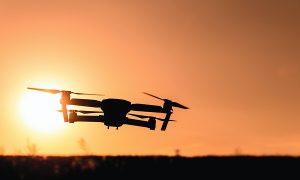
We’ve been familiar with the concept of drones for some years now. Their use in the military, for everything from bomb disposal to surgical strikes, is no longer the stuff of sci-fi, their recreational use (and misuse) by consumers and criminals makes the news headlines with increasing frequency and we’re all still waiting for our first drone delivery from Amazon.
But while we wait, other businesses have already begun to integrate drones into their workforce. Here we’ve collected some of the applications already in use to show how drones can improve the way we work and trigger new ideas for you, our readers, as to how you might be able to employ them in your business.
Keeping humans safe
A few years ago Easyjet started using drones to carry out aircraft inspections and now they are used for similar purposes in a range of industries. Inspecting an aircraft is not easy for a human. You have to get up to the height of the fuselage, then work your way around methodically, checking for minute signs of damage. A drone, by contrast, can access every part of the plane quickly and safely, gather high-definition imagery and be programmed to methodically cover every inch of the plane, so nothing is overlooked.
This highlights three key benefits of drones: their speed and agility, their ability to carry sensors and their tireless thoroughness.
These benefits are also being realised in industries such as construction, petrochemicals and shipping, where inspections need to be carried out at height, or underwater or using sensors to detect gas leaks or heat loss.
Capturing compelling images
The ability of drones to take great aerial photographs has opened up a huge advertising opportunity for businesses of all sizes. Once upon a time, if you wanted to run an ad featuring swooping aerial footage, you had to hire a helicopter, or perhaps some CGI, all at very high cost. Consequently it was the preserve of very big brands and their spectacular cinema ads.
But a drone mounted with a high quality camera makes the capture of exciting aerial shots affordable across the board, and more and more businesses are being able to utilise this in their creative marketing output on digital channels. The only question is ‘how creative are you?’
Covering more ground
Farming involves a lot of repetitive, methodical tasks. Ploughing fields, spraying crops, harvesting, inspecting fences, surveying buildings and livestock. Farm machinery has become increasingly programmable, to the point where humans are being taken out of the equation altogether and replaced with autonomous drone tractors that can manage the ploughing and harvesting all by themselves.
Meanwhile, the cowboy or shepherd, who used to spend all day riding the ranch or roaming the hills, can now carry out much of the animal husbandry with a drone. The benefits are that it can cover the ground in a fraction of the time and send back images from an aerial or low level perspective, thus spotting things that might go undetected at ground level.
Moving goods around
Delivery drones are ready to go; the only constraints are the air traffic regulations that require drones to remain in the line of sight of the pilot at all times. In countries where this stipulation doesn’t apply, delivery drones are already at work, ferrying medical supplies between hospitals and delivering goods across rivers.
But the logistical capability of drones doesn’t stop at deliveries. Drones are being used in warehouse management, fitted with scanners for automatic inventory control and helping to speed up the pick and pack process. They are used for transporting items within site too, freeing up human labour and adding a level of agility to the already established robot production line workforce.
Time to reach new heights?
In many respects, drones are answering the question of what humans could achieve if they had wings. But it’s not just the airborne capability of drones that provides opportunities for businesses. They can operate underwater, on the water and overland too. In some cases they have even negotiated tunnels.
Here we have covered just a handful of examples, chosen to illustrate the essential attributes of drones: speed and agility, safety, affordability, sensor carrying, weight carrying, tirelessness and thoroughness. If any of these are attributes you look for in new recruits, perhaps you should consider a drone. It could take to to whole new heights.
This article was written on behalf of Origo.is
Photo by JESHOOTS.com from Pexels


